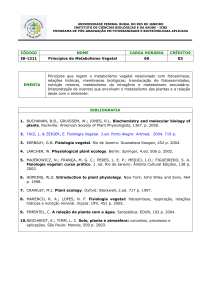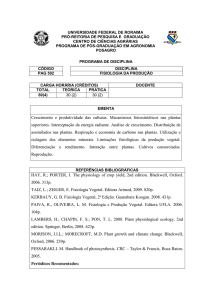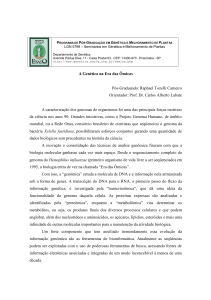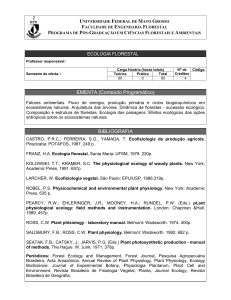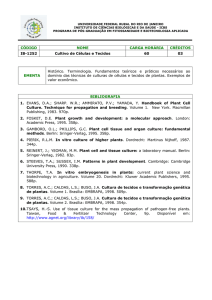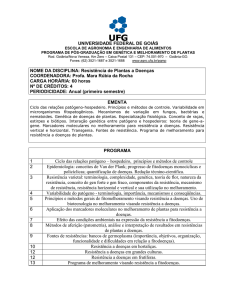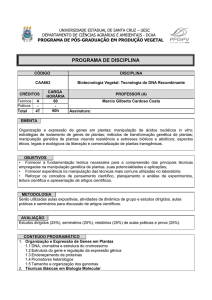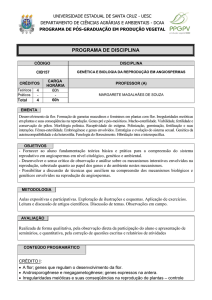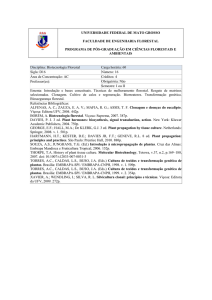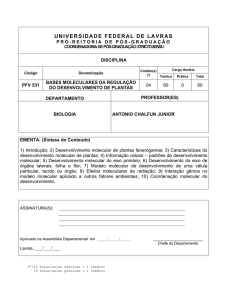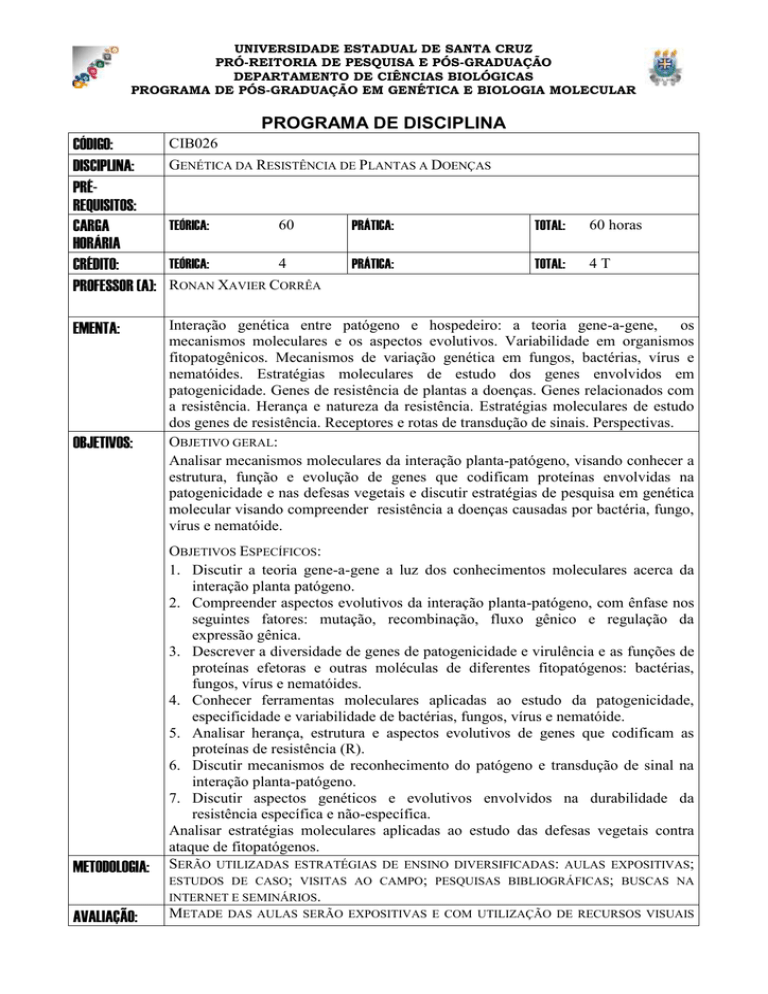
UNIVERSIDADE ESTADUAL DE SANTA CRUZ
PRÓ-REITORIA DE PESQUISA E PÓS-GRADUAÇÃO
DEPARTAMENTO DE CIÊNCIAS BIOLÓGICAS
PROGRAMA DE PÓS-GRADUAÇÃO EM GENÉTICA E BIOLOGIA MOLECULAR
PROGRAMA DE DISCIPLINA
CÓDIGO:
DISCIPLINA:
PRÉREQUISITOS:
CARGA
HORÁRIA
CRÉDITO:
PROFESSOR (A):
CIB026
EMENTA:
Interação genética entre patógeno e hospedeiro: a teoria gene-a-gene, os
mecanismos moleculares e os aspectos evolutivos. Variabilidade em organismos
fitopatogênicos. Mecanismos de variação genética em fungos, bactérias, vírus e
nematóides. Estratégias moleculares de estudo dos genes envolvidos em
patogenicidade. Genes de resistência de plantas a doenças. Genes relacionados com
a resistência. Herança e natureza da resistência. Estratégias moleculares de estudo
dos genes de resistência. Receptores e rotas de transdução de sinais. Perspectivas.
OBJETIVO GERAL:
Analisar mecanismos moleculares da interação planta-patógeno, visando conhecer a
estrutura, função e evolução de genes que codificam proteínas envolvidas na
patogenicidade e nas defesas vegetais e discutir estratégias de pesquisa em genética
molecular visando compreender resistência a doenças causadas por bactéria, fungo,
vírus e nematóide.
OBJETIVOS:
METODOLOGIA:
AVALIAÇÃO:
GENÉTICA DA RESISTÊNCIA DE PLANTAS A DOENÇAS
TEÓRICA:
60
4
TEÓRICA:
RONAN XAVIER CORRÊA
PRÁTICA:
TOTAL:
60 horas
PRÁTICA:
TOTAL:
4T
OBJETIVOS ESPECÍFICOS:
1. Discutir a teoria gene-a-gene a luz dos conhecimentos moleculares acerca da
interação planta patógeno.
2. Compreender aspectos evolutivos da interação planta-patógeno, com ênfase nos
seguintes fatores: mutação, recombinação, fluxo gênico e regulação da
expressão gênica.
3. Descrever a diversidade de genes de patogenicidade e virulência e as funções de
proteínas efetoras e outras moléculas de diferentes fitopatógenos: bactérias,
fungos, vírus e nematóides.
4. Conhecer ferramentas moleculares aplicadas ao estudo da patogenicidade,
especificidade e variabilidade de bactérias, fungos, vírus e nematóide.
5. Analisar herança, estrutura e aspectos evolutivos de genes que codificam as
proteínas de resistência (R).
6. Discutir mecanismos de reconhecimento do patógeno e transdução de sinal na
interação planta-patógeno.
7. Discutir aspectos genéticos e evolutivos envolvidos na durabilidade da
resistência específica e não-específica.
Analisar estratégias moleculares aplicadas ao estudo das defesas vegetais contra
ataque de fitopatógenos.
SERÃO UTILIZADAS ESTRATÉGIAS DE ENSINO DIVERSIFICADAS: AULAS EXPOSITIVAS;
ESTUDOS DE CASO; VISITAS AO CAMPO; PESQUISAS BIBLIOGRÁFICAS; BUSCAS NA
INTERNET E SEMINÁRIOS.
METADE DAS AULAS SERÃO EXPOSITIVAS E COM UTILIZAÇÃO DE RECURSOS VISUAIS
UNIVERSIDADE ESTADUAL DE SANTA CRUZ
PRÓ-REITORIA DE PESQUISA E PÓS-GRADUAÇÃO
DEPARTAMENTO DE CIÊNCIAS BIOLÓGICAS
PROGRAMA DE PÓS-GRADUAÇÃO EM GENÉTICA E BIOLOGIA MOLECULAR
(ESQUEMAS EM LOUSA E OS ESQUEMAS/DESENHOS, PROJETADOS EM TRANSPARÊNCIAS
OU DATA SHOW) E A OUTRA METADE COM BASE NA DISCUSSÃO DE ARTIGOS
CIENTÍFICOS ADERENTES AOS OBJETIVOS DA DISCIPLINA E AOS TEMAS DE
DISSERTAÇÃO E TESE DOS ALUNOS MATRICULADOS. O TEMA SERÁ A PARTIR DE
OBJETIVOS COLOCADOS DE FORMA PROGRESSIVA (DO GERAL PARA O ESPECÍFICO).
SERÁ SOLICITADO DO ALUNO LEITURA E ESTUDO DIRIGIDO EXTRA-CLASSE COM BASE
NOS OBJETIVOS CONSTANTES EM CADA PLANO DE UNIDADE. A VERIFICAÇÃO DA
APRENDIZAGEM (AVALIAÇÃO) SERÁ FEITA DESDOBRANDO-SE OS OBJETIVOS EM
QUESTÕES QUE ABRANJAM O CONTEÚDO MINISTRADO E PERMITAM AO ALUNO
MANIPULAR ESSE CONTEÚDO NOS DIFERENTES NÍVEIS COGNITIVOS. OS INSTRUMENTOS
DE AVALIAÇÃO CONSTARÃO DE: PROVAS ESCRITAS INDIVIDUAIS; TRABALHOS
ESCRITOS E ESTUDOS DIRIGIDOS (QUESTIONÁRIOS); DISCUSSÃO DE ARTIGOS
CIENTÍFICOS PREVIAMENTE LIDOS EXTRA-CLASSE PELOS ALUNOS; OBSERVAÇÕES EM
CAMPO OU LABORATÓRIO; ESTUDOS DE CASOS, SEMINÁRIOS E REVISÕES;
PARTICIPAÇÃO NAS DISCUSSÕES, AVALIAÇÃO INTER-PARES E AUTO-AVALIAÇÃO.
Os conteúdos serão organizados em três unidades temáticas, a partir dos objetivos
CONTEÚDO
PROGRAMÁTICO:
da disciplina e do perfil dos alunos integrantes de cada turma.
Unidade I – Conceitos fundamentais em genética da resistência
1. Teoria gene-a-gene e aspectos moleculares da interação planta-patógeno.
2. Aspectos evolutivos da interação planta-patógeno, com ênfase nos seguintes
fatores: mutação, recombinação, fluxo gênico e regulação da expressão gênica.
Unidade II – Patogenicidade e especificidade em fitopatógenos
3. Diversidade e funções de fatores de patogenicidade e virulência de bactérias,
fungos, vírus e nematóides.
4. Técnicas de biologia molecular no estudo da patogenicidade, especificidade e
variabilidade de fitopatógenos.
Unidade III – Defesas Vegetais
5. Estrutura e evolução de genes que codificam as proteínas de resistência (R).
6. Funções e mecanismos de ação das proteínas R, das proteínas relacionadas com
resistência (PR) e de outras moléculas envolvidas na interação planta-patógeno.
7. aspectos genéticos e evolutivos envolvidos na durabilidade da resistência
específica e não-específica
Estratégias moleculares aplicadas ao estudo das defesas vegetais contra ataque de
fitopatógenos.
REFERÊNCIA
AHN, J.H.; WALTON, J.D. Chromosomal Organization of TOX2, a Complex
UNIVERSIDADE ESTADUAL DE SANTA CRUZ
PRÓ-REITORIA DE PESQUISA E PÓS-GRADUAÇÃO
DEPARTAMENTO DE CIÊNCIAS BIOLÓGICAS
PROGRAMA DE PÓS-GRADUAÇÃO EM GENÉTICA E BIOLOGIA MOLECULAR
BIBLIOGRÁFICA:
Locus Controlling Host-Selective Toxin Biosynthesis in Cochliobolus carbonum
Plant Cell, v. 8, p. 887 a 897. 1996.
Ann-Maree Catanzariti,a,b Peter N. Dodds,a,1 Gregory J. Lawrence,a Michael A.
Ayliffe,a and Jeffrey G. Ellisa Haustorially Expressed Secreted Proteins from Flax
Rust Are Highly Enriched for Avirulence Elicitors. The Plant Cell, Vol. 18, 243–
256, 2006,
BAILEY, J. A., eds. (1986). Biology and Molecular Biology of Plant-Pathogen
Interactions. Heidelberg, Spring-Verlag.
BUSTAMONTE, P.I.; HULL, R. Plant virus genes expression strategis. Journal of
Biotechnology, v. 1, n. 2., pl 15. 1998.
CORNELIS, GR; GIJSEGEM, FV. Assembly and function of type III secretory
systems. Annu. Rev. Microbiol., v. 54, p.735-74. 2000.
CURSINO-SANTOS, JR; DEFINA, TPA; MARTINEZ-ROSSI, NM. Os segredos
das plantas e de seus patógenos na era molecular. Ribeirão Preto: SBG, 2003.
45p.
DAVIS, EL., HUSSEY, RS., BAUM, TJ. Getting to the roots of parasitism by
nematodes. TRENDS in Parasitology, v. 20, n. 3, 2004.
DE WIT, P.J.D.M. Pathogen avirulence and plant resistance: a key role for
recognition. Trends in Plant Science, v. 2, n. 12, p. 452-8, 1998.
FLOR-PARRA, I.; VRANES, M.; KAMPER, J.R.G; PEREZ-MARTIN, J. Biz1, a
Zinc Finger Protein Required for Plant Invasion by Ustilago maydis, Regulates the
Levels of a Mitotic Cyclin. Plant Cell, 2006.
GregoryB.Martin,Adam J. Bogdanove, andGuido Sessa Understanding The
Functions Of Plant Disease Resistance Proteins Annu. Rev. Plant Biol. 2003.
54:23–61
HAMMOND-KOSACK, K.E., JONES, J.D.G. Plant disease resistance genes.
Annu. Ver. Plant Physiol. Mol. Biol., v. 48,p. 575-607, 1997.
HARRISON, BD.; ROBINSON, DJ. Another quarter century of great progress in
understanding the biological properties of plant viruses. Annals of Applied
Biology (2005), 146:15-37
HUGHES, M.A. The molecular disease and pest resistance. Plant Molecular
Genetics. Harbow: Longman, 1996.
Hulbert, S.H.; Webb, C.A.; Smith, S.M.; Sun, Q. Resistance gene complexes:
Evolution and Utilization Annu. Rev. Phytopathol. 2001, Vol. 39: 285-312
ISAAC, S. (1992). Fungal-Plant Interactions. Chapman & Hall, New York. 418 p.
JANSSEN, R., BAKKER, J., GOMMERS, FJ. Mendelian proof for a gene-forgene relationship between virulence of Globodera rostochiensis and the H,
UNIVERSIDADE ESTADUAL DE SANTA CRUZ
PRÓ-REITORIA DE PESQUISA E PÓS-GRADUAÇÃO
DEPARTAMENTO DE CIÊNCIAS BIOLÓGICAS
PROGRAMA DE PÓS-GRADUAÇÃO EM GENÉTICA E BIOLOGIA MOLECULAR
resistance gene in Solanum tuberosum ssp. andigena CPC 1673. Revue Nénzatol.
14 (2) : 213-219 (1991)
Keyu Gu, Bing Yang, Dongsheng Tian, Lifang Wu, Dongjiang Wang, Chellamma
Sreekala Fan Yang, Zhaoqing Chu, Guo-Liang Wang, Frank F. White &
Zhongchao Yin R gene expression induced by a type-III effector triggers disease
resistance in rice Vol 435|23 June 2005|doi:10.1038/nature03630
KOSUGE, T. & NESTER, E. W., eds. (1984). Plant-Microbe Interections:
Molecular and Genetic Perspectives. vol. 1. New York, MacMillan Publishing
Company.
Leach, J.E.; Cruz, C.M.V.; Bai, J.; Leung, H. Pathogen fitness penalty as a
predictor of durability of disease resistance genes. Annu. Rev. Phytopathol. 2001,
v. 39, p. 187-224.
LEACH, JAN E.; CASIANA M. VERA CRUZ; JIANFA BAI; HEI LEUNG.
Pathogen fitness penalty as a predictor of durability of disease resistance genes.
Annu. Rev. Phytopathol. 2001. 39:187–224
LU , S-W.; Scott Kroken, Bee-Na Lee, Barbara Robbertse, Alice C. L. Churchill,
O. C. Yoder, and B. Gillian Turgeon. A novel class of gene controlling virulence
in plant pathogenic ascomycete fungi PNAS, vol. 100, no. 10, p. 5980–5985,
2003.
Martin, G.B. Bogdanove, A.J. and Sessa, G. Understanding the functions of plant
disease resistance proteins. Annu. Rev. Plant Biol., 2003, v. 54, p. 23-61.
MENDGEN, K.; HANN, M. Plant infection and the establishment of fungal
biotrophy. Trends in Plant Science, v. n. p. xxxx.
Michal Levy, Orit Edelbaum, and Ilan Sela Tobacco Mosaic Virus Regulates the
Expressionof Its Own Resistance Gene N Plant Physiology, August 2004, Vol.
135, pp. 2392–2397, www.plantphysiol.org _ 2004
MUDGETT, MB. New Insights to the Function of Phytopathogenic Bacterial Type
III Effectors in Plants Annu. Rev. Plant Biol. 2005.56:509-531.
NESTER, E. W. & VERMA, D. P. S., eds. (1993). Advances in Molecular
Genetics of Plant-Microbe Interactions. vol 2. Kluwer Academic Publishers,
Dordrecht. 617 p.
PANACCIONE, D.G.; SCOTT-CRAIG, J.S.; POCARD, J-A.; WALTON, J.D. A
cyclic peptide synthetase gene required for pathogenicity of the fungus
Cochliobolus carbonum on maize Proc. Nadl. Acad. Sci. USA. Vol. 89, pp. 65906594, 1992. (Plant Biology)
PATIL, S. S.; OUCHI, S.; MILLS, D. & VANCE, C., eds. (1991). Molecular
Strategies of Pathogens and Host Plants. Springer-Verlag, New York. 268 p.
RANSOM, R. F.; WALTON, J.D. Histone Hyperacetylation in Maize in Response
to Treatment with HC-Toxin or Infection by the Filamentous Fungus Cochliobolus
UNIVERSIDADE ESTADUAL DE SANTA CRUZ
PRÓ-REITORIA DE PESQUISA E PÓS-GRADUAÇÃO
DEPARTAMENTO DE CIÊNCIAS BIOLÓGICAS
PROGRAMA DE PÓS-GRADUAÇÃO EM GENÉTICA E BIOLOGIA MOLECULAR
carbonum Plant Physiology, v. 115, p. 1021 a 1027. 1997.
REHMEYER, C.; LI, W.; KUSABA, M; KIM, Y-S.; BROWN, D.; STABEN, C.;
DEAN, R.; FARMAN, M. Organization of chromosome ends in the rice blast
fungus, Magnaporthe oryzae. Nucleic Acids Research, Vol. 00, No. 00 1–17.
2006.
Reona Takabatake 1, Shigemi Seo 1, Ichiro Mitsuhara 1, Shinnya Tsuda 2 and
Yuko Ohashi Accumulation of the Two Transcripts of the N gene, Conferring
Resistance to Tobacco Mosaic Virus, is Probably Important for N Gene-dependent
Hypersensitive Cell Death Plant Cell Physiol. 47(2): 254–261 (2006).
ROOSSINCK, M.J. Mechanisms of plant virus evolution. Annu. Rev. of
Phytopathol., v. 35, p. 191-209.
ROSSI, M., GOGGIN, F.L. MILLIGAN, S.B. et al. The nematode resistance gene
Mi of tomato confers resistance against the potato aphid. Proc. Natl. Acad. Sci.
USA, v. 95, p. 9750-9754, 1998.
STACEY, G.; MULLIN, B. & GRESSHOFF, P. M., eds. (1996). Biology of
Plant-Microbe Interactions. International Society for Molecular Plant-Microbe
Interactions, St. Paul. 588 p.
Wei, Wensheng; Anne Plovanich-Jones*§, Wen-Ling Deng, Qiao-Ling Jin*, Alan
Collmer, Hsiou-Chen Huangi, and Sheng Yang He. The gene coding for the Hrp
pilus structural protein is required for type III secretion of Hrp and Avr proteins in
Pseudomonas syringae pv. Tomato. PNAS, vol. 97 no. 5, p 2247–2252. 2000.
WOLPERT, T.J., DUNKLE, L.D., CIUFFETTI, L.M. Host-selective toxins and
avirulence determinants: wat’s in a name? Annu. Rev. Phytopathol., 2002. v. 40,
p. 251-285.
ZAITLIN, M., PALUKAITIS, P. Advances in understanding plant viruses and
virus disease. Annu. Rev. Phytopalthol., v. 38, p. 117-143. 2000.

